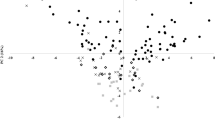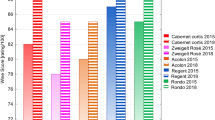Summary
With the aid of gaschromatographic-mas-spectrometric analysis, changes in the aroma constituents of wine were examined during storage in bottles. The investigation was carried out on wines of the variety Riesling from 10 different vintages (1964, 1973–1975, 1977–1982) of the same estate. Further, the composition of aroma compounds of a “frozen in” Riesling wine (6 years) was compared with the normally seasoned (“cellar-stored”) product. One to the achievement of chemical equilibrium in the aqueous-ethanolic solution, the constituents of acetic acid ester (acetates) decrease, the diethylesters of some dicarboxylic acids increase. Further, the formation of substances from the carotinoid degradation (vitispiranes, 1,1,6-trimethyl-1,2-dihydronaphtalene) and the carbohydrate degradation (dehydration reactions in acid solution) with the formation of 2-furfural, 2-hydroxymethyl-5-furfural among other compounds can be observed.
The monoterpenes show considerable changes during the aging of wine. The monoterpenealcohols Linalool, Geraniol and Citronellol decrease, the four isomers of Linalooloxide as well as Neroloxide, Hotrienol, Hydroxylinalool and Hydroxycitronellol increase.
Further, the formation of 2,6,6-trimethyl-2-vinyl-tetrahydropyran, 2,2-dimethyl-5-(1-methylpropenyl)-tetrahydrofuran, cis-1,8-terpin and the two isomers of Anhydrolinalooloxide was established.
Zusammenfassung
Mit Hilfe der gaschromatographisch-massenspektrometrischen Analysentechnik wurden die Veränderungen in den Gehalten der Aromastoffe des Weines bei der Flaschenlagerung untersucht. Die Untersuchungen wurden an Weinen der Rebsorte Riesling von 10 verschiedenen Jahrgängen (1964,1973–1975,1977–1982) aus dem gleichen Weingut durchgeführt. Ferner wurde die Aromastoffzusammensetzung eines „eingefrorenen” Rieslingweines mit der normalgelagerten („kellergelagerten”) Variante aus dem gleichen Gärgebinde verglichen.
Infolge der chemischen Gleichgewichtseinstellung in der wäßrig-ethanolischen Lösung nehmen die Gehalte der Essigsäureester (Acetate) ab, die Gehalte der Di- und Monoethylester von Dicarbonsäuren zu. Ferner werden die Bildung bzw. die Gehaltszunahme von Substanzen aus dem Carotinoid-Abbau (Vitispirane, 1,1,6-Trimethyl-1,2-dihydro-naphtalin) und dem Kohlenhydrat-Abbau (Dehydratisierungsreaktionen in saurer Lösung) unter Bildung u. a. von 2-Furfural, 2-Hydroxymethyl-5-furfural (HMF) beobachtet. Die Monoterpene erfahren während der Alterung des Weines z. T. beträchtliche Veränderungen. Die Gehalte der Monoterpenalkohole Linalool, Geraniol und Citronellol nehmen ab, die Gehalte der vier isomeren Linalooloxide sowie von Neroloxid, Hotrienol, Hydroxylinalool und Hydroxycitronellol nehmen zu.
Ferner wird die Bildung von 2,6,6-Trimethyl-2-vinyl-tetrahydropyran, von 2,2-Dimethyl-5-(1-methylpropenyl)-tetrahydrofuran, von cis-1,8-Terpin sowie
Similar content being viewed by others
Literatur
Güntert M (1984) Gaschromatographisch-Massenspektrometrische Untersuchungen flüchtiger Inhaltsstoffe des Weinaromas: Beitrag zur Sortencharakterisierung der Rebsorte Weißer Riesling. Dissertation, Universität Karlsruhe
Schreier P (1979) Flavor composition of wines. A review. CRC Crit Rev Food Sci Nutr 12:59–111
Rapp A, Hastrich H, Engel L (1976) Gaschromatographische Untersuchungen der Aromastoffe von Weinbeeren. 1. Anreicherung und kapillarchromatographische Auftrennung. Vitis 15:29–36
Mandery H (1983) Gaschromatographisch-Massenspektrometrische Untersuchungen flüchtiger Inhaltsstoffe des Traubenmost-und Weinaromas: Auswirkung der Süßung auf die Aromazusammensetzung. Dissertation, Universität Karlsruhe
Rapp A, Güntert M, Almy J (1984) Neue schwefelhaltige Aromastoffe im Wein -cis- und trans-2-Methyl-thiolan-3-ol. Vitis 23:66–72
Marais J (1978) The effect of pH on esters and quality of Colombar wine during maturation. Vitis 17:396–403
Marais J (1979) Effect of storage time and temperature on the formation of dimethyl sulfide and on white wine quality. Vitis 18:254–260
Marais J, Pool HJ (1980) Effect of storage time and temperature on the volatile composition and quality of dry white table wines. Vitis 19:151–164
Simpson RF (1978) Aroma and compositional changes in wine with oxidation, storage and aging. Vitis 17:274–287
Simpson RF (1979) Aroma composition of bottle aged white wine. Vitis 18:148–154
Simpson RF, Miller GC (1983) Aroma composition of aged Riesling wine. Vitis 22:51–63
Shinohara T, Watanabe M (1981) Effects of fermentation conditions and aging temperature on volatile ester contents in Wine. Agric Biol Chem 45:2645–2651
Onishi M, Guymon JF, Crowell EA (1977) Changes in some volatile constituents of brandy during aging. Am J Enol Vitic 28:152–158
Ramey DD, Ough CS (1980) Volatile ester hydrolysis of formation during storage of model solutions and wines. J Agric Food Chem 28:928–934
Dittrich HH (1977) Handbuch der Getränketechnologie. Mikrobilogie des Weines. Verlag Eugen Ulmer, Stuttgart, S 70
Di Stefano R (1983) Identificazione degli esteri etilici degli acidi 2 - ossi glutarico e 2-ossi glutarico y-lattone nei vini. Vitis 22:220–224
Ohloff G (1978) Recent developments in the field of naturally-occuring aroma components. Fortschr Chem Org Naturst 35:431–527
Ohloff G, Rautenstrauch V, Schulte-Elte KH (1973) Modellreaktionen zur Biosynthese von Verbindungen der DamasconReihe und ihre präparative Anwendung. Helv Chim Acta 56:1503–1513
Williams PJ et al. (1982) Use of C18-reversed-phase liquid chromatography for the isolation of monoterpene glycosides and norisoprenoid precursors from grape juice and wines. J Chromatogr 235:471–480
Simpson RF, Strauss CR, Williams PJ (1977) Vitispirane: a C13-spiro-ether in the aroma volatiles of grape juice, wines and distilled grape spirits. Chem Ind pp 663-664
Simpson RF (1978) 1,1,6-Trimethyl-1,2-dihydronaphthalene: an important contributor to the bottle aged bouquet of wine. Chem Ind S. 37
Masuda M, Nishimura K (1980) Occurence and formation of Damascenone, trans-2,6,6-Trimethyl-l-crotonyl-cyclohexa-1,3-diene in alcoholic beverages. J Food Sci 45:396–397
Enzell CR (1981) Influence of curing on the formation of tabacco flavour. In: Schreier P (ed) Flavour '81, Verlag Walter de Gruyter, Berlin New York, pp 449–478
Renold W et al. (1974) An investigation of the tea aroma. 1. New volatile black tea constitutents. Helv Chim Acta 57:1301–1308
Feather MS, Harris JF (1973) Dehydration reactions of carbohydrates. Adv Carbohydr Chem Biochem 28:161–224
Theander O (1980) In: Koivistoinen P, Hyvönen L (eds) Carbohydrate sweeteners in foods and nutrition, Academic Press, London, pp 185–199
Tressl R, Kossa T, Holzer M (1975) Bildung flüchtiger Aromastoffe durch Maillard-Reaktionen. In: Drawert F (Hrsg) Geruchs- und Geschmacksstoffe, Verlag Hans Carl, Nürnberg, 33–47
Shallenberger RS, Birch GG, Sugar chemistry (1975) The Avi Publishing Company, Inc, pp 169-193
Heyns K, Stute R, Paulsen H (1966) Bräunungsreaktionen und Fragmentierungen von Kohlenhydraten. Teil 1: Die flüchtigen Abbauprodukte der Pyrolyse von D-Glucose. Carbohydr Res 2:132–149
Fagerson IS (1969) Thermal degradation of carbohydrates, a review. J Agric Food Chem 17:747–750
Alberola J, Izquierdo LJ (1978) The volatile fraction of orange juice. Methods for extraction and study of composition. In: Charalambous G (ed): Flavour of foods and beverages, chemistry and technology, Academic Press, New York, pp 283–304
Nagy S, Randall V (1973) Use of furfural content as an index of storage temperature abuse in commercially processed orange juice. J Agric Food Chem 21:272–275
Dinsmore HL and Nagy S (1972) Colorimetric furfural measurement as an index of deterioration in stored citrus juices. J Food Sci 37:768–770
Simpson RF (1980) Volatile aroma components of australian port wines. J Sci Food Agric 31:214–222
Yamanishi T (1978) The aroma of various teas. In: Charalambous G (ed): Flavour of foods and beverages, chemistry and technology, Academic Press, New York, pp 305–328
Walradt JP, Lindsay RC, Libbey LM (1970) Popcorn flavour: Identification of volatile compounds. J Agric Food Chem 18:926–928
Schreier P et al. (1976) Anwendung der multiplen Diskriminanzanalyse zur Differenzierung von Rebsorten an Hand der quantitativen Verteilung flüchtiger Weininhaltsstoffe. Mitt Klosterneuburg 26:225–234
Schreier P, Drawert F, Junker A (1977) Gaschromatographische Bestimmung der Inhaltsstoffe von Gärungsgetränken. X. Quantitative Bestimmung von Weinaromastoffen im myg/1-Bereich. Chem Mikrobiol Technol Lebensm 5:45–52
Belitz HD, Grosch W (1982) Lehrbuch der Lebensmittelchemie, Springer Verlag, Berlin Heidelberg New York, 685
Stevens KL, Jurd L, Manners G (1972) Transformations of Geraniol in aqueous acid solutions. Tetrahedron 28:1939–1944
Baxter RL, Laurie WA, McHale D (1978) Transformations of Monoterpenoids in aqueous acids. Tetrahedron 34:2195–2199
Klein E, Rojahn W (1963) Die säurekatalysierte Isomerisierung von Alkoholen und Diolen der azyklischen Monoterpenreihe. Dragoco Rep 11:239–247
Verghese J (1970) Perfumery and flavouring chemicals - I α-Ter-pineol. Flavour Ind 1:791–793
Williams PJ, Strauss CR, Wilson B (1980) Hydroxylated linalool derivates as precursors of volatile monoterpenes of muscat grapes. J Agric Food Chem 28:766–771
Williams P, Strauss CR, Wilson B (1981) Classification of the monoterpenoid composition of muscat grapes. Am J Enol Vitic 32:230–235
Rapp A, Mandery H, Heimann W (1983) Untersuchungen über die flüchtigen Inhaltsstoffe von rektifiziertem Traubenmostkonzentrat. Dtsch Lebensm-Rundsch 79:361–365
Askar A, Bielig HJ, Treptow H (1973) Aromaveränderungen von Orangensaft. Dtsch Lebensm-Rundsch 69:162–167
Schreier P, Drawert F, Junker A (1974) Identifizierung von 3,7Dimethyl-1,5,7-octatrien-3-ol als flüchtige Komponente des Trauben- und Weinaromas. Z Lebensm Unters-Forsch 155:98
Ribéreau-Gayon P, Boidron JN, Terrier A (1975) Aroma of muscat grape varieties. J Agric Food Chem 23:1042–1047
Strickler H, Kovats E sz (1966) Zwei Monoterpenoxide aus dem sog. „destillierten” Limetten-Öl. Helv Chim Acta 49:2055–2067
Rapp A, Knisper W (1980) Eine neue Methode zur Anreicherung von Dampfraumkomponenten. Dargestellt am Beispiel des Weines. Chromatographia 13:698–702
Ohloff G, Schulte-Elte KH, Willhalm B (1964) Zur Darstellung von Tetrahydropyran- und Tetrahydrofuranderivaten aus 1,7-bzw. 1,6-Allyldiolen durch Dehydratation in der Allylstellung. Helv Chim Acta 47:602–626
Author information
Authors and Affiliations
Additional information
Auszug aus der Dissertation von M. Güntert, Universität Karlsruhe, 1984 der zwei isomeren Anhydrolinalooloxide festgestellt.
Rights and permissions
About this article
Cite this article
Rapp, A., Güntert, M. & Ullemeyer, H. Über Veränderungen der Aromastoffe während der Flaschenlagerung von Weißweinen der Rebsorte Riesling. Z Lebensm Unters Forch 180, 109–116 (1985). https://doi.org/10.1007/BF01042633
Received:
Accepted:
Issue Date:
DOI: https://doi.org/10.1007/BF01042633




